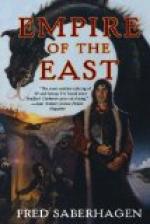Round the waist are three separate belts, the first a common belt, then the leather “kolan” for the support of the weapons, and over all a silk sash, the “pas,” sometimes twenty yards long, wound round and round many times and of brilliant colours.
Below, knee-breeches of dark blue material and voluminous proportions, called “gace,” bordered round the pockets with gold-work, and high, patent-leather boots. This latter is merely modern dandyism; the still invariably worn “dokoljenice” are white gaiters, fastened at the back with hooks and eyes, which reach to the “opanki”—shoes made of a flat leather sole, bound over with a thick network of whipcord.
The ordinary costume of the better classes for everyday wear (and this is the uniform of the officers) is a short red jacket, embroidered like the waistcoat in black silk, with sleeves carried either hussar fashion, hanging behind, or over the sleeves of the waistcoat.
Then there are green gunj and even dark blue. The peasant wears usually a coarse white serge gunj for every day and an ordinary shirt.
In the mountain districts and borderlands of the Brda the Albanian costume of tight-fitting white serge trousers, bordered with black braid, is largely worn.
The women wear a somewhat modified array of colour. The girls wear the kapa, without the letters or rainbow; the married women a lace mantilla over their shoulders. The hair is worn, in the case of the married women, in a heavy crown-like plait.
A white, slightly embroidered bodice, silver girdle, and silk skirt, over which is worn a similar open coat to the gunj. And again over this comes the “jecerma,” a jacket of red, blue, or violet velvet, according to the age of the woman.
The effect in both men and women is tasteful and picturesque in the extreme.
The struka, or shawl, is greatly worn by men, and the sweeping, swinging effect is most pleasing. It is a shawl of sufficient length that when folded to a narrow width and worn over the shoulders the tassels just touch the ground.
Some of the poorest peasants wear huge sheepskin jackets, even in hot weather.
At the head of the Greek Orthodox Church, which is the religion of the land, is an Archbishop, or “Vladika.” Hardly more than half a century ago, the Vladika was Prince and Bishop in one. To-day the Vladika is absolute spiritual head of the Church in Montenegro, and only in matters pertaining to divorce are his rulings reversible by the Prince.
The hatred of the Roman Catholic religion is most marked. The term “Catholic” is an epithet of opprobrium. Hence the hatred of Albania, which on the borders is entirely Roman Catholic. The hated Catholics also, in the shape of Austria, hem in Montenegro on three sides, and this factor, added to the unfriendly part that Austria played at the Berlin Congress, may account for the growing animosity which is now slowly making itself manifest against




